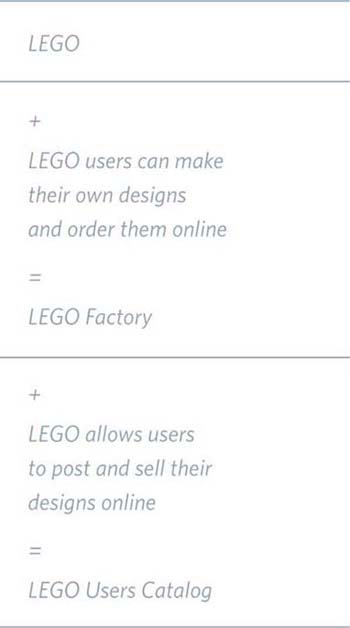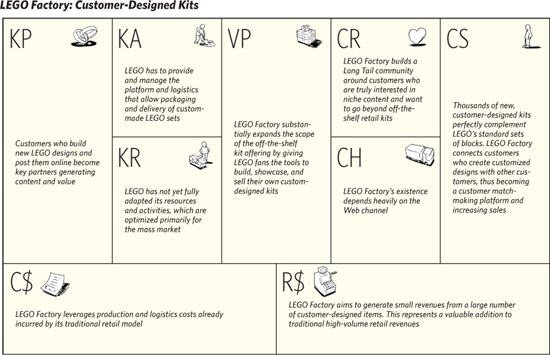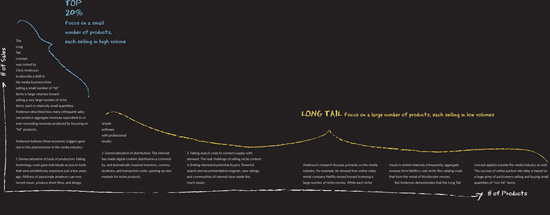
The Long Tail
Def_Pattern No. 2
LONG TAIL BUSINESS MODELS are about selling less of more: They focus on offering a large number of niche products, each of which sells relatively infrequently. • Aggregate sales of niche items can be as lucrative as the traditional model whereby a small number of bestsellers account for most revenues. • Long Tail business models require low inventory costs and strong platforms to make niche content readily available to interested buyers.
[ REF·ER·ENCES ]
1 • The Long Tail: Why the Future of Business Is Selling Less of More. Anderson, Chris. 2006.
2 • “The Long Tail.” Wired Magazine. Anderson, Chris. October 2004.
[ EX·AM·PLES ]
Netflix, eBay, YouTube, Facebook, Lulu.com

The Long Tail concept was coined by Chris Anderson to describe a shift in the media business from selling a small number of “hit” items in large volumes toward selling a very large number of niche items, each in relatively small quantities. Anderson described how many infrequent sales can produce aggregate revenues equivalent to or even exceeding revenues produced by focusing on “hit” products.
Anderson believes three economic triggers gave rise to this phenomenon in the media industry:
1. Democratization of tools of production: Falling technology costs gave individuals access to tools that were prohibitively expensive just a few years ago. Millions of passionate amateurs can now record music, produce short films, and design simple software with professional results.
2. Democratization of distribution: The Internet has made digital content distribution a commodity, and dramatically lowered inventory, communications, and transaction costs, opening up new markets for niche products.
3. Falling search costs to connect supply with demand: The real challenge of selling niche content is finding interested potential buyers. Powerful search and recommendation engines, user ratings, and communities of interest have made this much easier.
Anderson’s research focuses primarily on the media industry. For example, he showed how online video rental company Netflix moved toward licensing a large number of niche movies. While each niche movie is rented relatively infrequently, aggregate revenue from Netflix’s vast niche film catalog rivals that from the rental of blockbuster movies.
But Anderson demonstrates that the Long Tail concept applies outside the media industry as well. The success of online auction site eBay is based on a huge army of auctioneers selling and buying small quantities of “non-hit” items.
The Transformation of the Book Publishing Industry

Old Model
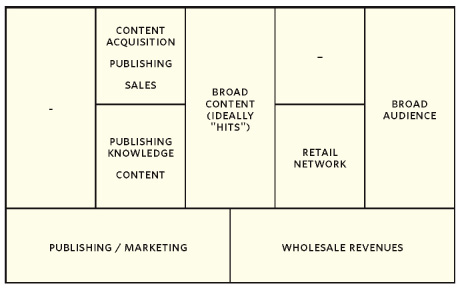
We’ve all heard about aspiring authors who carefully craft and submit manuscripts to publishing houses in the hope of seeing their work in print—and face constant rejection. This stereotypical image of publishers and authors holds much truth. The traditional book publishing model is built on a process of selection whereby publishers screen many authors and manuscripts and select those that seem most likely to achieve minimum sales targets. Less promising authors and their titles are rejected because it would be unprofitable to copyedit, design, print, and promote books that sell poorly. Publishers are most interested in books they can print in quantity for sale to large audiences.
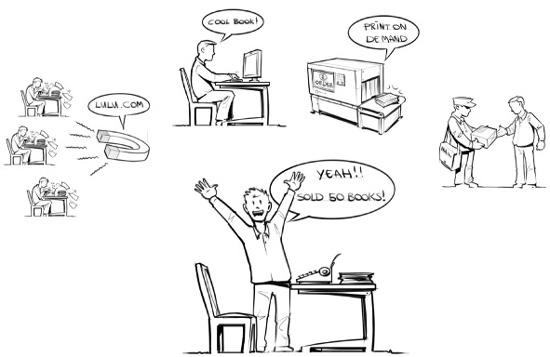
A New Model
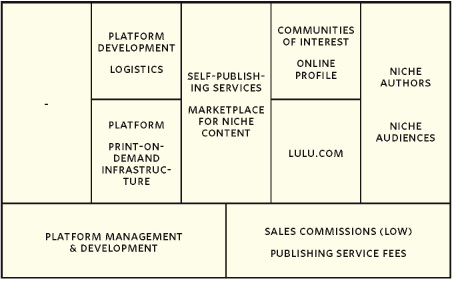
Lulu.com turned the traditional bestseller-centric publishing model on its head by enabling anyone to publish. Lulu.com’s business model is based on helping niche and amateur authors bring their work to market. It eliminates traditional entry barriers by providing authors the tools to craft, print, and distribute their work through an online marketplace. This contrasts strongly with the traditional model of selecting “market-worthy” work. In fact, the more authors Lulu.com attracts, the more it succeeds, because authors become customers. In a nutshell, Lulu.com is a multi-sided platform (see Multi-Sided Platforms) that serves and connects authors and readers with a Long Tail of user-generated niche content. Thousands of authors use Lulu.com’s self-service tools to publish and sell their books. This works because books are printed only in response to actual orders. The failure of a particular title to sell is irrelevant to Lulu.com, because such a failure incurs no costs.
LEGO®’s New Long Tail
The Danish toy company LEGO started manufacturing its now famous interlocking bricks in 1949. Generations of children have played with them, and LEGO has released thousands of kits around a variety of themes, including space stations, pirates, and the Middle Ages. But over time, intensifying competition in the toy industry forced LEGO to seek innovative new paths to growth. It started licensing the rights to use characters from blockbuster movies such as Star Wars, Batman, and Indiana Jones. While such licensing is expensive, it proved to be an impressive revenue generator.
In 2005 LEGO started experimenting with user-generated content. It introduced LEGO Factory, which allows customers to assemble their very own LEGO kits and order them online. Using software called LEGO Digital Designer, customers can invent and design their own buildings, vehicles, themes, and characters, choosing from thousands of components and dozens of colors. Customers can even design the box containing the customized kit. With LEGO Factory, LEGO turned passive users into active participants in the LEGO design experience. This requires transforming the supply chain infrastructure, and because of low volumes LEGO has not yet fully adapted its support infrastructure to the new LEGO Factory model. Instead, it simply tweaked existing resources and activities.
In terms of a business model, though, LEGO took a step beyond mass customization by entering Long Tail territory. In addition to helping users design their own LEGO sets, LEGO Factory now sells user-designed sets online. Some sell well; some sell poorly or not at all. What’s important for LEGO is that the user-designed sets expand a product line previously focused on a limited number of best-selling kits. Today this aspect of LEGO’s business accounts for only a small portion of total revenue, but it is a first step towards implementing a Long Tail model as a complement—or even alternative—to a traditional mass-market model.
